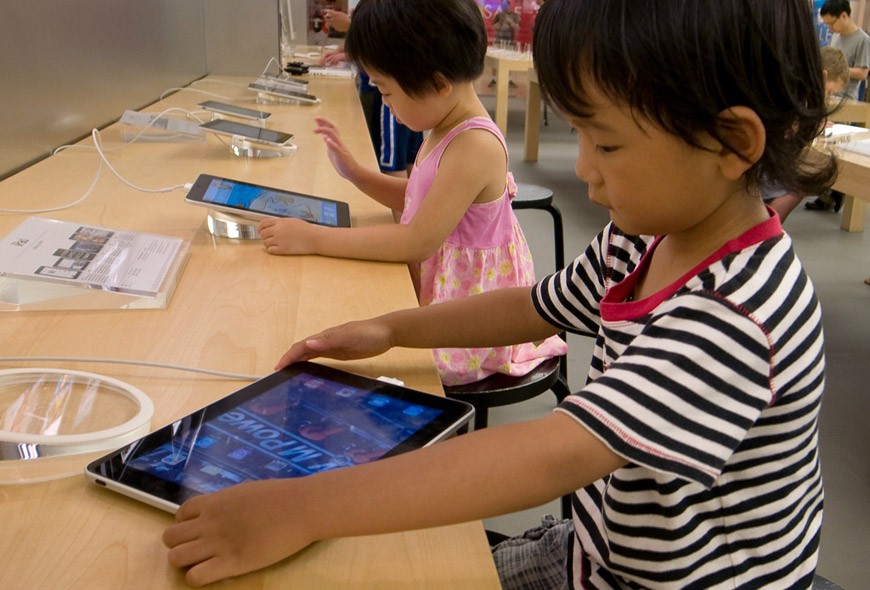It’s no longer a stretch to say that we’re on our way to a dystopian society – where you go out to a restaurant, look around, and see everybody’s eyes glued to their smartphones and gadgets.
Although this rise of technology has revolutionized the field of communication, it has also deteriorated social interaction. It has given us countless opportunities but has created numerous bad habits that need to be addressed. What may be even more concerning is the effect technology is having on the youngest generation.
Babies are being raised on iPads and elementary school children won’t put their Nintendo DS down. Before we breed a generation of robots, we must take a look at the true capabilities of technology.
How Much is Too Much?
Although technology has given us the opportunity to communicate instantly, share our opinions and photos, and establish a professional web presence, it must be used in modification. We’re often referred to as the “generation of nostalgia,” because we know a world without technology.
We grew up in simpler times with Crayola and Play Doh and then were catapulted into a world of computers, cell phones and video games.
The rise of technology means that the next generations won’t know a world without their precious iPhones and Xbox consoles, or the ways in which technology has made everyday life easier.
Even more disconcerting is the fact that current studies are showing the various behavioral problems that are rising in this new era of technology.
Children on average spend about seven and a half hours each day staring at screens, according to a report by the Kaiser Family Foundation. A Pew survey also revealed that texting is now the primary mode of communication between teens and their friends and family instead of phone calls and face-to-face interactions.
Further, this study found that an average young person spends 10,000 hours playing video games by age 21. To put that into perspective, that’s approximately 5 years of 40-hour workweeks and is more than double the amount the average college student spends earning a bachelor’s degree.
That’s too much.
Problems Are Surfacing From Technology
Various behavioral issues and health problems have been linked to the rise of technology and constant technology use. First, it has been linked to childhood obesity. Instead of running around outside and playing tag, children are becoming couch potatoes. Pressing buttons doesn’t burn too many calories.
Not only are children failing to get the daily exercise they need, but they are also subject to advertisements for junk food and candy all day. They’ll go grab a bag of Cheetos or M&Ms from the kitchen to munch on while bummin’ on the couch, entranced in the world of technology before them.
Another problem that’s surfacing from consistent technology use is the rising number of children diagnosed with ADHD. The way that kids concentrate on video games is completely different from the type of concentration needed to be successful in school.
When kids rack up points in a game and are rewarded with unlocking characters and making it to higher levels, their brains are rewarded by dopamine. They’re learning how to pay attention when there’s a reward involved, but not in the absence of rewards.
ADHD medication given to children increases dopamine activity to control the ADHD, so by becoming immersed in the world of video games, children are essentially self-medicating and getting the extra dopamine that their bodies need.
Another problem that stems from this is that kids who love the exciting world of video games often return to reality and are disappointed or underwhelmed by it. This simply creates more of an issue in focusing on schoolwork and other activities outside of the virtual world.
The overuse of technology is also destroying young people’s ability to interact in social settings. Instead of communicating face-to-face, children and teens are reducing conversation down to text messages and Facebook chats. This is also increasing the amount of social anxiety. The feelings of comfort and confidence are only existent behind a screen.
Moreover, hearing loss prevention should also be a top priority for parents regarding the usage of gadgets and devices as it will also affect their socio and motor skills. Remember that excessive noise exposure from gadgets can also lead to health issues, such as eye problems or hearing impairment.
Parents should learn more about hearing loss from websites like Audiologists.org because hearing loss is permanent and can have long-term effects on children.
Early detection and intervention are crucial, as untreated hearing loss can impact a child’s speech development, academic performance, and social interactions. These websites offer valuable resources on recognizing early signs of hearing loss, understanding its potential causes, and exploring treatment options.
By educating themselves, parents can take proactive steps to protect their children’s hearing health, ensuring that any issues are addressed promptly to minimize long-term consequences.
Too much screen time may also be linked to mood problems among teens. Researchers at Queen’s University in Canada found that youths who indulge in computer use for more than 3-4 hours a day were 50 percent more likely to engage in risky behaviors such as drinking, drug use, smoking and unprotected sex.
Ads on the web are far less regulated than ads on TV so young people are becoming exposed to these behaviors which instills a curiosity to emulate them.
Insight From A Teacher and Mother
Lauren Kliewer is a 27-year-old teacher currently working toward her Master’s degree in Special Education and is the mother of a 2-year-old daughter. She tells MiLLENNiAL that, “technology is used inappropriately quite often with most children.
Lots of parents and teachers are using it as a babysitter— simply sitting them down in front of a movie instead of spending time with their children or using technology for educational purposes.”
She says that in raising her own child throughout this technological era, she will, “make sure whatever she’s watching has a purpose and is something she can learn from.
There are so many resources to teach children at home, like Internet sites where they can learn letters early or different game apps that allow them to interact with parents.”
She adds that because her daughter is only 2-years-old she hasn’t tackled the cell phone issue yet, but she knows it’s not going to be something she gets to have all the time. “The biggest thing is to make sure we know what she’s doing TV or computer-wise and to make sure that we’re monitoring it.”
Lauren also stresses the importance of playing outside. “I see kids coming into high school and their whole lives were spent sitting in front of the TV. You can definitely tell a difference in the respects of being cultured and able to problem solve on their own. There’s also a problem with the understanding of social interaction and social queues.”
How the “Off” Button Could Change Lives
In addition to avoiding increased risk for obesity, ADHD, social anxiety and technological addictions, the “off” button could help youths in numerous ways. Children need to disconnect from the virtual world and venture into their backyards.
Playing outdoors allows children to use their brains in unique ways and create an understanding of the new stimuli using their senses of sight, hearing, smell, and touch.
There is no instruction manual for how to play outside. Kids are free to use their imagination and make up their own rules, enhancing creativity, intelligence and negotiation skills.
Playing in nature also reduces anxiety in a physiological way. Another physiological benefit of playing outside is the improvement of the immune system.
The solution to this complex problem of technology overuse isn’t so complex: parents. You have the power to make the rules in the house, so limit technology use to no more than two hours per day. Inspire your kids to reconnect with the Earth.
Remember when a sunny day was all it took for a game of Tag or Red Rover to make for an afternoon of fun?
The Rise of Technology and Its Impact on Childhood Development
In a world increasingly dominated by technology, it’s vital to consider its impact on our lives, especially for the younger generation.
Balancing screen time with outdoor play fosters creativity and social skills, essential for healthy development. Let’s reclaim simpler joys and ensure our children grow up with a balanced approach to technology and life.




